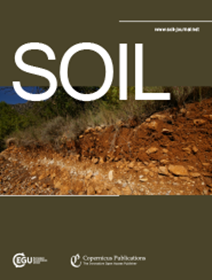Warming accelerates the decomposition of root biomass in a temperate forest only in topsoil but not in subsoil
IF 4.3
2区 农林科学
Q1 SOIL SCIENCE
引用次数: 0
Abstract
Abstract. Global warming could potentially increase the decomposition rate of soil organic matter (SOM), not only in the topsoil (< 20 cm) but also in the subsoil (> 20 cm). Despite its low carbon content, subsoil holds on average nearly as much SOM as topsoil across various ecosystems. However, significant uncertainties remain regarding the impact of warming on SOM decomposition in subsoil, particularly root-derived carbon, which serves as the primary organic input at these horizons. In the Blodgett Forest warming experiment (California, USA), we investigated whether warming accelerates the decomposition of root-litter at three depths (10–14, 45–49, and 85–89 cm) by using molecular markers and in-situ incubation of 13C-labelled root-litter at each depth. Our results reveal that the decomposition of added root-litter was only accelerated in the topsoil (10–14 cm) but not in the subsoil (45–49 and 85–89 cm) with warming. In subsoil, although the decomposition rate of root-litter derived carbon did not differ significantly between ambient and warmed plots, the underlying reasons for this similarity are distinct. With molecular marker analysis, we found higher microbial activity, indicated by higher concentration of certain fatty acid monomers that could be originally microbial-derived such as octadecanoic acid (C18:0 fatty acids), octadecenoic acid (C18:1 fatty acids), and hexadecanoic acid (C16:0 fatty acids) than those originally derived from roots in ambient subsoil. With warming, the higher concentration of long-chain (C number > 20) 𝜔-hydroxy acids and diacids left after 3 years of root incubation suggested a lower turnover rate and this could be due to lower microbial abundance and lower soil moisture induced by warming. Our study demonstrates that the impact of warming on the decomposition of root-litter in a temperate forest is depth-dependent. The slower turnover rate of long-chain 𝜔-hydroxy acids and diacids shows that they are more persistent compared to bulk root mass and could be preserved in subsoil for longer time as long as the environmental conditions are unfavorable for decomposition with warming.在温带森林中,变暖只会加速表层土壤根系生物量的分解,而底土则不会
摘要。全球变暖可能会增加土壤有机质(SOM)的分解速度,而不仅仅是表层土壤(<;20厘米),但也在底土(>;20厘米)。尽管其碳含量低,但在各种生态系统中,底土的平均SOM含量几乎与表土一样多。然而,关于变暖对地下土壤中SOM分解的影响,特别是作为这些层的主要有机输入的根源碳,仍然存在很大的不确定性。在美国加利福尼亚州的Blodgett森林增温实验中,我们利用分子标记和13c标记的凋落物原位孵育研究了增温是否加速了3个深度(10-14、45-49和85-89 cm)凋落物的分解。结果表明,增温只加速了表层土壤(10 ~ 14 cm)凋落物的分解,而无助于深层土壤(45 ~ 49 cm和85 ~ 89 cm)的分解。在底土中,虽然枯落物碳的分解速率在环境样地和温暖样地之间没有显著差异,但这种相似性的潜在原因是不同的。通过分子标记分析,我们发现了更高的微生物活性,这表明某些脂肪酸单体的浓度更高,这些脂肪酸单体可能最初是微生物衍生的,如十八烷酸(C18:0脂肪酸)、十八烯酸(C18:1脂肪酸)和十六烷酸(C16:0脂肪酸),而不是最初来自周围地下土壤根系的脂肪酸。随着升温,长链(C数>;20)𝜔-hydroxy根培养3年后留下的酸和二酸表明周转率较低,这可能是由于变暖导致微生物丰度降低和土壤湿度降低。我们的研究表明,气候变暖对温带森林凋落物分解的影响是深度依赖的。长链𝜔-hydroxy酸和二酸的周转率较慢,表明它们比块根质量更持久,只要环境条件不利于随着变暖而分解,它们就可以在地下保存更长的时间。
本文章由计算机程序翻译,如有差异,请以英文原文为准。
求助全文
约1分钟内获得全文
求助全文
来源期刊

Soil
Agricultural and Biological Sciences-Soil Science
CiteScore
10.80
自引率
2.90%
发文量
44
审稿时长
30 weeks
期刊介绍:
SOIL is an international scientific journal dedicated to the publication and discussion of high-quality research in the field of soil system sciences.
SOIL is at the interface between the atmosphere, lithosphere, hydrosphere, and biosphere. SOIL publishes scientific research that contributes to understanding the soil system and its interaction with humans and the entire Earth system. The scope of the journal includes all topics that fall within the study of soil science as a discipline, with an emphasis on studies that integrate soil science with other sciences (hydrology, agronomy, socio-economics, health sciences, atmospheric sciences, etc.).
 求助内容:
求助内容: 应助结果提醒方式:
应助结果提醒方式:


